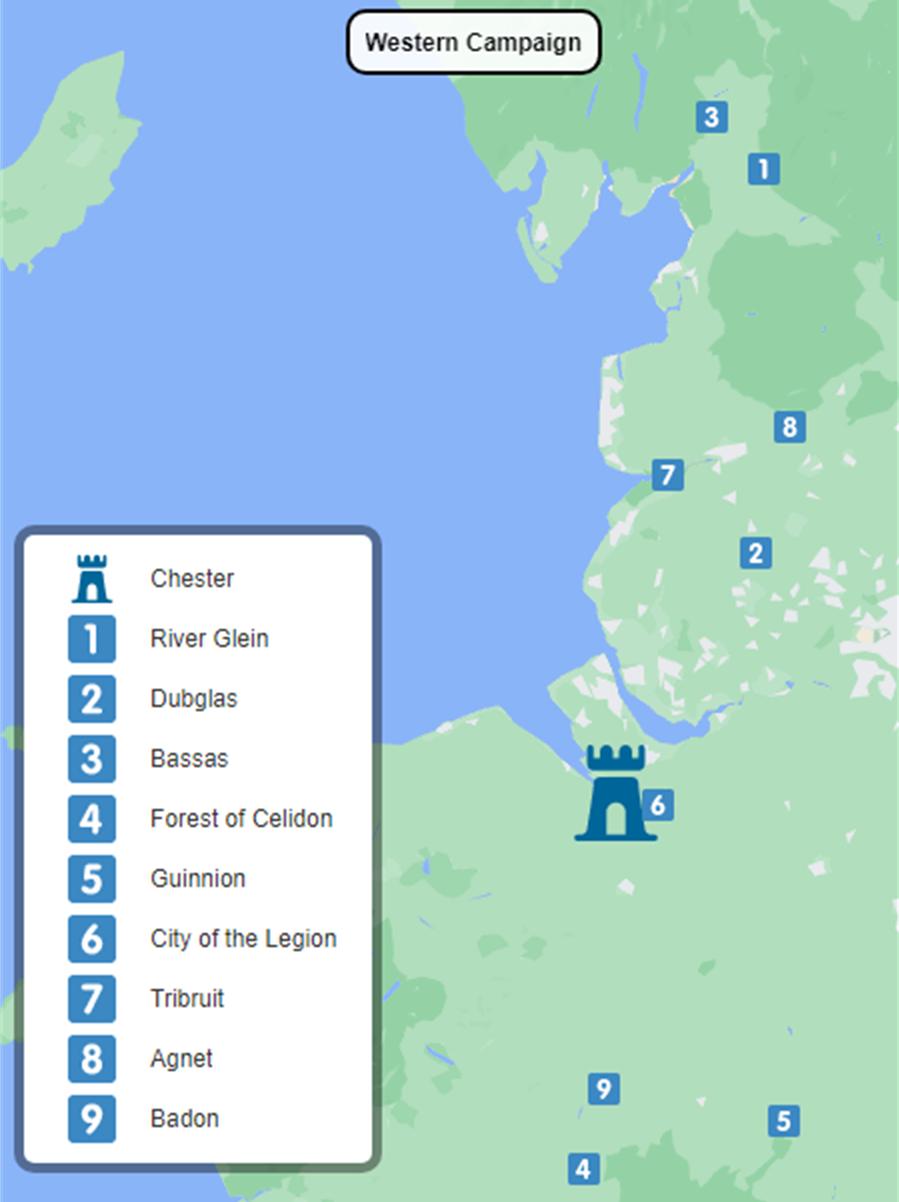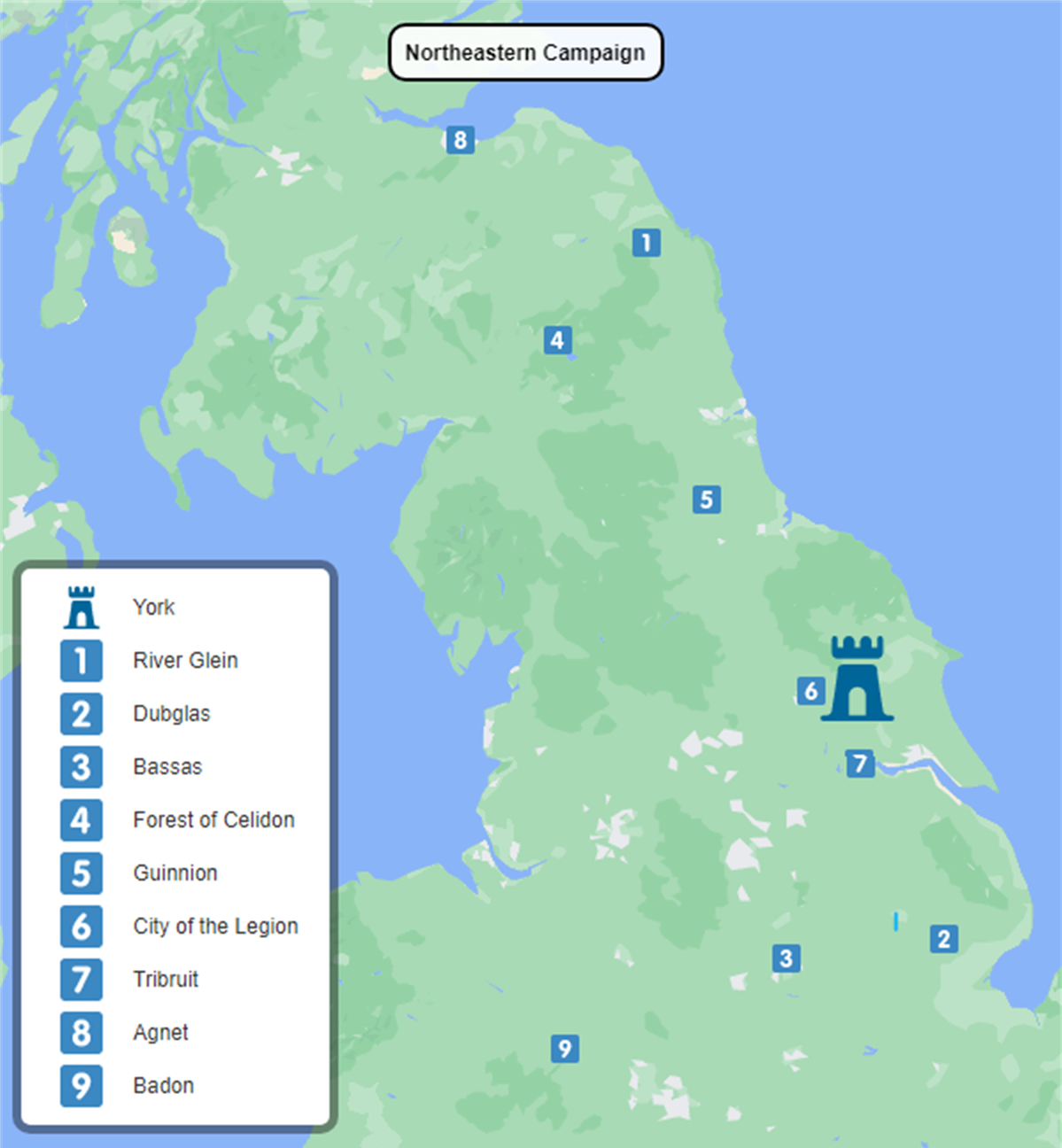Here we are going to map out some potential campaigns from possible sites for Arthur's twelve battles listed in Nennius. You can find the full list of sites for the twelve battles here
If Arthur existed, he would have started his campaigns at the earliest it would seem around the mid 480's, culminating in a generation spanning peace brought on by a victory at Badon after 10 to 15 years of fighting.
The Germanic presence in Britain would have been quite significant at this point, with settlers from the continent bolstering the already powerful warbands that spawned from Foederati troops that revolted after Roman exit in 410.
The Southern Campaign
First we will look at one of the most concentrated possible campaigns, a mapping of the southern possibilities for the battles. This campaign seems to have mostly been concentrated on territory that was within what was considered Brythonic prior to roughly 540.
Here Glein is situated at the River Glyme in Oxfordshire starting the campaign, very close to the Saxon frontier at the time. From there we have the four battles above the Dubglas, here at Devil's Brook in Dorset. This rather small stream may have formed a natural frontier. The next battle of Bassas is seen here at Bassingbourn in Cambridgeshire, an outlier here in this campaign, and seemingly deep in Saxon territory, a retaliatory attack? Celidon is hard to place in the south, but here mapped at Gellideg maps closely with the next few battles. Guinnion may have been fought at the old Roman town of Durocornovium, with southern candidate for the City of the Legion being Caerleon, with Tribruit taking place at the Twrc Estuary nearby. Catbrain has been equated with the alternate name of Agned, Breguoin. From there we have one of the commonly attributed sites of Badon, a campaign culminating here at what's now known as Little Solsbury Hill.
Proponents of a Dumnonian Arthur would find this campaign interesting as if the opponents were mainly Germanic these seem to be mostly defensive battles, with very little contact on Saxon territory, outside of Glein which is on the frontier, and Bassas which is on Saxon land.
An interesting possible commander for this southern campaign is the famous Geraint ap Erbin, the subject of the later romance of Geraint and Enid, king of Dumnonia around this time. Geraint is often featured as a member of Arthur's court, however some have surmised he was Arthur
The Western Campaign
Significantly less focused than the potential southern campaign, and much deeper into Brythonic territory overall. There are some interesting coincidences in naming here, mostly derived around the Lune, and I wouldn't discount some of these sites as possible.
The battle of Glein taking place at what is now the Lune in Lancaster, a river that still bears a name derived from Glein. A short trip south gives us a site for the Dubglas, the River Douglas in Lancashire. Back north gives us an intriguing possibility we discussed for Bassas. The old Roman fort on the Kent of Alavana, or Medibogdo, after this quite a trek, all the way into the territory of Powys for Cat Coit Celidon, at the Clune Forest. Guinnion may have then been a battle at a hillfort known as The Wrekin just a short march from the Clune Forest. The Wrekin happens to also be a candidate for Badon as well. The next is the "City of the Legion" or in this instance Chester, which was in Arthur's time known as Caer Legion. Tribruit and Agned are back north again, in Rheged's territory. Tribruit taking place at the Ribble estuary, and Agned following shortly afterward at Ribchester. The western campaign culminates in the final battle of Badon at The Breidden, another large hillfort, which is a possibility for the second Battle of Badon in 665.
Most of this campaign takes place in what at the time was Rheged, with the southernmost battles taking place in what was Powys. Meirchion Gul (Possibly the King Mark of Tristan and Isolde fame) would have been king of Rheged at the time, while Cadell likely reigned in Powys. If this was the campaign (or another similar western campaign) Nennius' recorded maybe it instead was a list of later battles, maybe ones fought in the mid to late 6th century, as part of a fading defensive frontier against the Northumbrians?
Cadell's Border Campaign.
For the sake of brevity I am not going to include a full write up of this campaign, as I don't think this is a major possibility, but it is interesting to see that it ends up looking like a border securing campaign for Powys.
The Northeastern Campaign.
This is another spread out campaign, that possibly isn't just against Germanic invaders (Angles were the likely foreign opponent here) but against Britons as well.
Starting at one of the generally well considered sites for Glein, is the Northumbrian Glen a first battle, deep into what was the still Brythonic kingdom of Bryneich, so either a deep Angle incursion, or a fight against King Dyfnwal Moelmud, a Coeling. From there we head to the south to Lindsay, attacking the early Angle settlements deep into their territory, at the River Witham. A short trip to the east gives us Bassingbourn in Cambridgeshire, our eastern Bassas, possibly pursuing a fleeing enemy? The Kielder Forest is the most likely candidate for Celidon yet, perfectly fitting for Arthur's Celidon, and the later Arfderydd. Guinnion is likely the old Roman Fort at Binchester, possibly a battle fought on the way back south, still in Dyfnwal's territory. The City of the Legion here of course would be York, the seat of power for the Kingdom of Ebrauc. Arthwys ap Mar, one of the many candidates for Arthur would have ruled here at this time, possibly a battle defending his home? Tribruit could be at the confluence of three rivers in the Humber estuary, chasing a fleeing foe into the Marsh that surrounded the area? Agned is of course Edinburgh, possibly a fight against the Gododdin, or maybe helping them defeat a deep Anglish incursion?Now we have Badon once again. This time at The Wrekin, not only a candidate for this Badon but also for Caer Faddon, and the Second Battle of Badon.
The most likely candidate to lead this campaign is the shadowy Coeling, the King of Ebrauc Arthwys ap Mar. York is fairly central to this campaign, which makes sense. There are interesting reasons to believe that not all of these battles were against the Angles. As I have discussed in this thread, it may be that Garbanian, Arthwys great uncle took the throne of Ebrauc for some time, with Arthwys eventually taking it back.


This conflict could possibly have involved Glein (maybe the beginning of Arthwys taking his kingdom back) and Guinnion, both in Garbanian's territory of Bryneich. There is also reason to believe that there was bad blood between the Coelings and the Gododdin. This could give a reading of Agned as being a battle against the Gododdin, an interesting possibility. This northeastern campaign is intriguing, and there does seem to be a logic to it, as well as Arthwys having a Arthur adjacent name adding further weight to it.
The Twelve Battles of King Arthur: The Breton sites.
This is mostly based on the work of Ronald Millar from his book "Will the Real King Arthur Please Stand Up?" This book is generally not well regarded, but the identified sites are interesting.
The Arthurian story was quite popular among the ancestors of modern Bretons, who were cousins to the Brythonic peoples in Britain. Quite a bit of the later tales have parts of their origins in the tales that were developed in Brittany, so a Breton angle isn't out of the question. The interesting thing here is that placenames have remained relatively unchanged compared to Britain proper. This is one of the reasons why Millar makes such a convincing case. The only battles that come off as a big stretch are Bassas, Badon.
The Sites
On to the battles. Glein is placed at the River Vilaine, which was originally the river Gwilen, from there the next four battles are placed at the River Daoulas, in Leon (formerly Linnius, or Lyonesse), Bassas is placed at the Ile De Batz in the north. This is one of the stretches that doesn't seem to fit as well as the others. Celidon then leads us to the Forest of Quenecan, which was once known as Gerlidon. Guinnion is Castel Guennon supposedly in Tregon, and the City of the Legion is situated at Vannes. Tribruit is at the river Trieaux which was formerly the Trifrouit. Agned would then take place at Sainte-Anne-d'Auray, and Badon at Baden shortly south. Baden is questionable as it would be hard to construe it as the Mount Badon Gildas was familiar with.
Coincidences?
It is interesting to see that so many of these names are so close to one another. The likelihood of this campaign being the correct one is slim however, as Gildas, who supposedly lived in Brittany towards the end of his life pretty well placed Badon in Britain proper. The most likely scenario is that the Brythonic people who settled Armorica(Brittany) carried their placenames with them as evidenced by names like Cornouaille, Domnonea, and others. Their language and culture being much more well preserved due to not being displaced by Germanic settlement, would naturally lead to some similarities in these placenames, while ones in Britain have been supplanted by names of Germanic Origin. It is still an interesting possibility that the maybe the later traditions of Arthur's battles on the continent could be a memory of this campaign if it indeed happened, and maybe strengthens the idea that Riothamus was Arthur.
Camlann
Camlann was going to be part of this article, but it is best to give it it’s own room to breathe. This is already reaching 2000 words, and the entry on Camlann itself is already over 3000, so I’d prefer to split them up. Mordred also gets significant attention in this next entry, so that should be fun. As always, thank you, and remember to follow me on twitter and subscribe here.











